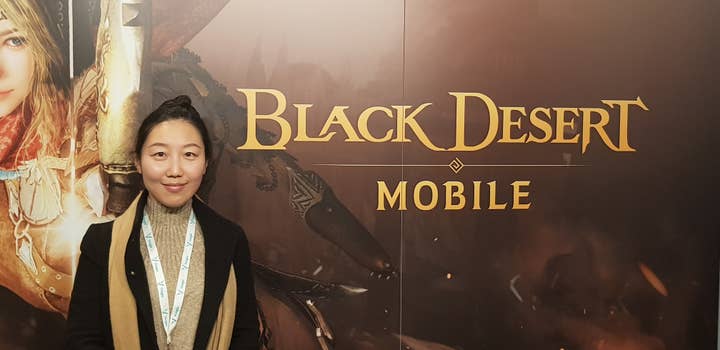Black Desert Online and the diverging MMO ecosystem
Pearl Abyss America CEO Jeonghee Jin discusses the changing face of MMO monetisation
The MMO market is not what it used to be, and how these games operate and thrive has changed in ways both large and small. Business models have evolved, competition for players' time has increased elsewhere in the games industry, and there is simply a more diverse range of online games available.
There was a time, not so long ago, when MMOs were the next big thing. Blizzard was enjoying unprecedented levels of success with World of Warcraft, which launched in November 2004 and quickly sold millions.
At its peak in 2010, Warcraft boasted over 12 million subscribers, and Blizzard's position as MMO top dog was unassailable. That was not through a lack of trying on behalf of other developers and publishers. In fact, the success of Warcraft led to an MMO gold rush, which saw game companies from around the world desperately clinging onto Blizzard's coattails as it rode off into the sunset on its multi-billion dollar horse.
As Blizzard marched forward, accruing ever more subscribers, it left a trail of broken and battered MMOs in its wake, such as The Matrix Online, Tabula Rasa, and Warhammer Online: Age of Reckoning to name a few. That's not to mention the games which either never made it to market -- like John Romero's MMO for kids -- or lacked a high-profile IP, like Auto Assault, APB: All Points Bulletin, and Vanguard: Saga Of Heroes.
The MMO market has shifted considerably in the years since however. Even the biggest subscription-based MMOs like Final Fantasy XIV and World of Warcraft now offer a considerable amount of free content, other MMO contenders like Guild Wars 2 have abandoned the monthly fee model entirely, favouring a free-to-play structure.

Black Desert Online, from Korean developer Pearl Abyss, is one of the more successful modern MMOs. First released in Korea in 2015, it operates on a free-to-play model in Asia and a on-time purchase (pay-to-play) model in the West. Although it was launched long after the MMO tide had ebbed, Pearl Abyss America CEO Jeonghee Jin says competition in the space is no less intense.
"Personally I think the MMO markets are diverging," she tells GamesIndustry.biz at Pocket Gamer Connects in London. "People's standards and expectations are getting higher and higher because they have experienced a lot of different MMOs by now, and they... want to know what these MMOs can offer in terms of technology, graphics, and the game experience."
MMOs are moving in two distinct directions, Jin says, as developers either lean into bigger and better, complete with all the conveniences of modern experiences, or a more rugged and stripped-back experience like Old School Runescape and World of Warcraft Classic.
"The competition is only getting more fierce, but at the same time when you think of WoW Classic or Old School Runescape doing so well, people have some nostalgia for their initial MMO experience from the '90s or '00s... People's tastes are not just converging to better quality, more convenience features, more degrees of freedom... I think there are also core MMORPG experiences that people kind of miss, so I think there are diverging trends and different things that people are looking for at the same time."
"The competition is only getting more fierce, but at the same time when you think of WoW Classic or Old School Runescape doing so well, people have some nostalgia for their initial MMO experience"
Although we've moved beyond both the MMO gold rush, the space is no less contested -- less populated, yes, but the Darwinism at play within the ecosystem has left us with just a handful of very successful games. What does it take to compete in this space though, when high-profile MMOs like WildStar are shut down after four difficult years?
"We put technology as our top priority," says Jin. "We built our own proprietary game engine just for Black Desert... I also think [our developers] wanted to see if there are other game engines that could have helped with faster development, but in the end they created their own. That's also what we're doing with our new projects in order to create what we really want to; we build our own technologies to support it, and it's not just for the game development, it's for the live service.
"Using our own engine and live service experience, we put a continuous effort to improve the game starting from the launch date... To be honest, we were not really successful with our first launch in Korea, but the team didn't give up. We launched and updated with more content and more patches just hoping to make it better and better. So until now we've just had this crazy amount of pitches and content updates. There were hopes and ambitions in the team, who believed in the product that it's going to work."
With live-service games increasingly becoming the norm, developers are competing for people's time as much as their money. Fewer, bigger, better is the order of the day in AAA spaces, while indie devs also lean more and more into games-as-a-service.
"Eventually players also evaluate all of these different models and just find out what works best for them"
Meanwhile subscription models both inside and outside the games industry offer a diverse range of content for less than a month of Warcraft. The rise of these services coincides with the devaluation of digital content as consumers expect a lot in exchange for very little.
"When we see the trends, of course, of the very traditional subscription model as dying, it's not because the subscription model itself really doesn't offer any value anymore," says Jin. "But I think there are more and more games that are free-to-play or non-subscription based, and just a one time purchase and the developers give them constant updates.
"So I think there are other things that probably come with more value than ongoing subscription; there are going to be more challenges to those subscription-based games, but I think eventually players also evaluate all of these different models and just find out what works best for them."
Jin adds that the future of MMOs is not necessarily a question about subscription versus pay-to-play or free-to-play -- but that it's ultimately a value proposition for the consumer.
"So I think even for subscriptions, if they really just like the content, if they believe in the value they are getting for the subscription, of course they are going to pay... The subscription model will survive, but probably in a little different way, because there is more and more competition between free-to-play games and not free-to-play, whether they are subscription-based or a one time purchase model. So it's going to be hard for them to survive for a long time, but I don't think it's going to be free-to-play versus subscription... I don't think it's one over the other is going to survive and the other is going to die. You just have to have players evaluate whenever they have to pay."

